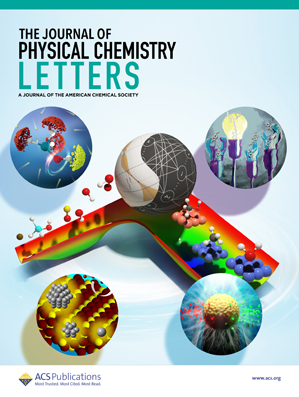Dehydration-Driven Glass Formation in Aqueous Carbonates
IF 4.8
2区 化学
Q2 CHEMISTRY, PHYSICAL
引用次数: 0
Abstract
Amorphous carbonates, in their liquid and solid (glassy) forms, have been identified to play important roles in biomineralization, volcanism, and deep element cycling. Anhydrous amorphous calcium and calcium–magnesium carbonate (ACC and ACMC05, respectively) are structural glasses that exhibit a glass transition upon being heated. We report a significant effect of the water content on glass formation. The results yield a parametrization enabling prediction of the stability of their liquid and solid amorphous phases as a function of temperature and water content. These results, obtained through novel fast differential scanning calorimetry, demonstrate that hydrous ACC and ACMC05 do indeed exhibit the behavior of structural glasses and that dehydration of these materials by lyophilization is a route that can be used to isothermally cross the glass transition. This work presents a viable process for a significantly wider range of geo- and biomaterials. Dehydration-controlled formation of glassy ACC therefore constitutes the missing link in the transformation from supersaturated aqueous solutions through an intermediate amorphous glassy state to crystalline CaCO3 polymorphs. These results yield direct implications for the mechanistic interpretation of geological processes and biomineralization.在含水碳酸盐中脱水驱动玻璃形成
液态和固态(玻璃状)的无定形碳酸盐在生物矿化、火山作用和深部元素循环中起着重要作用。无水无定形钙和碳酸钙镁(分别为ACC和ACMC05)是加热后呈现玻璃化转变的结构玻璃。我们报告了水含量对玻璃形成的显著影响。结果产生了一个参数化,可以预测它们的液体和固体非晶相的稳定性作为温度和含水量的函数。这些结果是通过新型快速差示扫描量热法获得的,表明含水ACC和ACMC05确实表现出结构玻璃的行为,并且通过冻干对这些材料进行脱水是一种可用于等温跨越玻璃化转变的途径。这项工作为更广泛的地理和生物材料提供了一个可行的过程。因此,脱水控制的玻璃状ACC的形成构成了过饱和水溶液通过中间非晶玻璃态到结晶CaCO3多晶转变的缺失环节。这些结果对地质过程和生物矿化的机理解释具有直接意义。
本文章由计算机程序翻译,如有差异,请以英文原文为准。
求助全文
约1分钟内获得全文
求助全文
来源期刊

The Journal of Physical Chemistry Letters
CHEMISTRY, PHYSICAL-NANOSCIENCE & NANOTECHNOLOGY
CiteScore
9.60
自引率
7.00%
发文量
1519
审稿时长
1.6 months
期刊介绍:
The Journal of Physical Chemistry (JPC) Letters is devoted to reporting new and original experimental and theoretical basic research of interest to physical chemists, biophysical chemists, chemical physicists, physicists, material scientists, and engineers. An important criterion for acceptance is that the paper reports a significant scientific advance and/or physical insight such that rapid publication is essential. Two issues of JPC Letters are published each month.
 求助内容:
求助内容: 应助结果提醒方式:
应助结果提醒方式:


